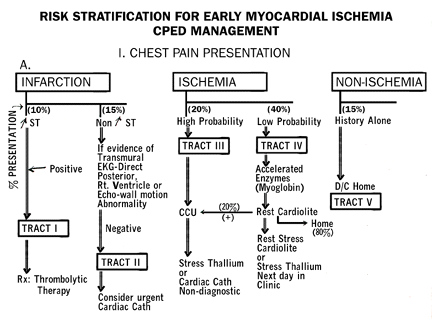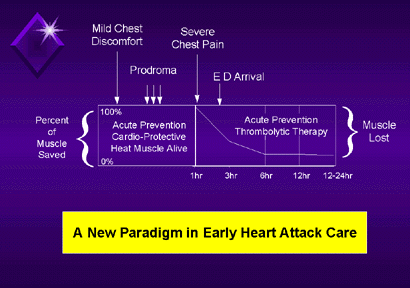Course Authors
Raymond D. Bahr, M.D., FACP, FACC
Medical Director, The Paul Dudley White Coronary Care System St. Agnes HealthCare, Baltimore, MD
Dr. Bahr reports no commercial conflict of interest. This presentation will include discussion of commercial products and services.
Estimated course time: 1 hour(s).

Albert Einstein College of Medicine – Montefiore Medical Center designates this enduring material activity for a maximum of 1.0 AMA PRA Category 1 Credit(s)™. Physicians should claim only the credit commensurate with the extent of their participation in the activity.
In support of improving patient care, this activity has been planned and implemented by Albert Einstein College of Medicine-Montefiore Medical Center and InterMDnet. Albert Einstein College of Medicine – Montefiore Medical Center is jointly accredited by the Accreditation Council for Continuing Medical Education (ACCME), the Accreditation Council for Pharmacy Education (ACPE), and the American Nurses Credentialing Center (ANCC), to provide continuing education for the healthcare team.
Upon completion of this Cyberounds®, you should be able to:
Describe the strategy for establishing Chest Pain Centers
Focus on prevention of and early intervention for myocardial ischemia
Develop a clinical pathway for the patient with low probability of ischemic disease.
Dr. Raymond Bahr started the first Chest Pain Center in Baltimore in 1981. At that time it was not unusual for someone with a minor laceration or a stubbed toe to get more attention than a patient with a heart attack. They were "trauma" patients and emergency departments were focused on trauma. We now know that if a patient with an acute MI can be diagnosed and treated within one hour after the onset of chest pain his or her mortality risk can be reduced by more than eight-fold! Despite this, some see such specialized centers as serving more a marketing than a medical function. Dr. Bahr has generously agreed to discuss what such centers can offer.
I think you will enjoy it very much.
Richard W. Smalling, M.D., Ph.D., Cardiovascular Editor
The number of Chest Pain Centers has grown exponentially within the last five years. In 1992, there were only about 100 Chest Pain Centers. In 1997, there are estimated to be more than 1,000. This growth pattern is similar to that of Coronary Care Unit s back in the early 1960s. Though it is true that some hospitals may enter the scene strictly from a marketing viewpoint to gain access to the market, a better explanation is that their time has come.
Clinical guidelines for what constitutes a "Chest Pain Center" have already been published in the American Journal of Cardiology. In the January, 1997 issue of the Annals of Emergency Medicine almost the entire issue is devoted to chest pa in strategy and Chest Pain Centers. The editorial by Dr. Brian Gibler(1) in this issue puts aside the marketing criticism by citing four studies, also included in that issue, which show the kind of positive contributio n such centers can make. Instead, he addresses the question, "Chest Pain Centers: Do They Make Sense Now? (For those interested in the subject of Chest Pain Centers, the January, 1997 issue of the Annals of Emergency Medicine is must reading.)
The real question facing us should be the the challenge, "What can we do about the problem of "heart attacks" in the world? How can we lessen their incidence and improve survival rates?" Answering such a question requires that we use both factual and interpretive medicine. Interpretive medicine,(2) as defined by Richard Horton, editor of the Lancet, is as much a part of our day to day medical practice as evidence-based medicine. If medicine is still to be defined as a science and an art, then interpretive medicine is the art of applying evidence-based medicine to the facts that we have at hand. How can we take our factual evidence-based medicine, interpret it the best and develop a universal strategy for the purpose of taking heart disease ou t of first place as the deadliest disease, a place it has occupied since the turn of the century. The idea behind Chest Pain Centers is to engineer a creative solution to the heart attack problem. Bear with me as we perceive current facts differently(3) to see the sense behind the growth in Chest Pain Centers in Emergency Departments throughout the United States and the world.
The strategy of focusing specifically on chest pain developed as a grassroots attempt at the community hospital level to focus on and achieve better results regarding the heart attack problem. It is modeled on the success of the Coronary Care Unit. It attempts to bring together emergency physicians, cardiologists, critical care nurses, paramedics, EMS personnel, etc., in a team-like(4) effort with a comprehensive management strategy for the evaluation of triage of chest pain patients.
Since most heart attack patients present with chest pain, it is in the Emergency Department where the "rubber hits the road" and action first needs to be taken. Nationally, physicians in the American College of Emergency Physicians and the American College of Cardiology have already come together to put together the initial guidelines and definition for Chest Pain Units in Emergency Departments.(5)
The Three Components of a Chest Pain Center
Three components appear to be necessary for these units. The first is that patients crashing with an acute myocardial infarction need to be quickly identified and given prompt opening therapy be it thrombolytic or PTCA.

Figure 1.


The second component is an Observation Unit. Once acute myocardial infarction has been ruled out, this unit attempts to determine which patients with chest pain are more likely to have myocardial ischemia (moderate probability) and which are unlikely to have myocardial ischemia (low probability). This element of the center is extremely important because the number of chest pain patients admitted to critical care units or even stepdown units, simply for fear of sending potential heart attack patients ho me, has greatly increased the cost of health care. Such patients can be worked up in Observation Units of Chest Pain Centers over a six- to eight-hour period of time with an 80% discharge rate, actually cutting costs.
The Observation unit allows the third component of such centers, the educational outreach component, to be effective by, as Dr. Gibler puts it in his editorial, "providing for the success of a low probability ischemic pathway work up in which 80% of such patients can be sent home...." This third component of the Chest Pain Center focuses on prevention and community education. It makes sure the community learns the warning signs of heart attacks, that heart attacks can be detected and prevented if patients can identify the sensation of chest pressure (prodromal stage) as being significant before it becomes chest pain and life-threatening.
Avoiding Unnecessary and Expensive Treatment While Closing Up the Cracks
In this way, Chest Pain Centers have helped develop a clinical pathway for the patient with low probability of ischemic disease so that they receive neither too much nor too little treatment, avoiding the unnecessary expense of time in critical care units, yet not allowing patients with clear warning signs of heart problems to fall through the cracks until they present with a heart problem that is more definitively life-threatening.
The importance of this last issue was underscored in a recent editorial in the New England Journal of Medicine by Dr. Eugene Braunwald.(6) He points out that the occurrence of patients with prodromal myocardial infarc tion is equal to MI patients without such a prodrome. This finding was recently brought out in the GUSTO II Study in which 44% of the 4,000 patients with acute myocardial infarction and ST elevation had intermittent symptoms for up to a week prior to their myocardial infarction. More patients may be saved with acute prevention at the prodromal unstable angina stage, as opposed to waiting for the acute myocardial infarction to occur. The mortality difference in the GUSTO II trial between prodromal myocardial infarction and prodromal unstable angina was 5.2% to 3.28%.
Thus, the Chest Pain Movement and Chest Pain Center concept is based on acute prevention of a heart attack by targeting patients with prodromal symptoms of a heart attack.(7) It tends to spur developments, both within these Chest Pain Centers as well as within the community, linking an effective educational campaign with a user friendly check-out system within the hospital's emergency department.(8),(9) As shown in Figure 2, it attempts to shift the paradigm away from cardiac arrest and acute myocardial infarction (both of which need to be perceived as failures in detecting and preventing early stages of chest pain from developing into more serious problems) toward prevention and ea rly intervention. It is felt that the potential for saving lives is much greater with this approach than the present one which appears to focus on patients with crashing myocardial infarction, where the yield to date has been surprisingly very disappointing.

Figure 2.


Summary
In summary, Chest Pain Centers have developed in response to a real need, not a marketing strategy. This is the need to significantly reduce heart attack deaths within the U.S.A.. Seen in this light, they come across as a real innovation rather than marketing hype. It is important to remember that the scientific data on the success of Coronary Care Units came out long after each community hospital had set one up. It just made sense to do it early. It was an "idea whose time had come." It is far les s expensive to change an Emergency Department, shifting its mindset with regard to chest pain from one of rapid disposition to one of observation medicine, than to build an expensive CCU. It is this expansion of the mindset and attitude of the Emergency Department staff that makes a Chest Pain Center successful and responsive to the needs of its community.